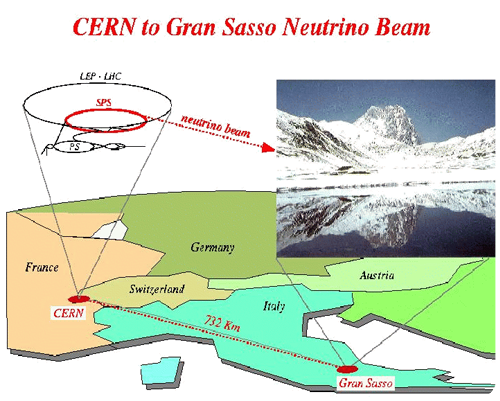Although I went on record that the reportedly faster than light neutrinos from CERN to OPERA will likely go away as mere systematic error, and although my very own resolution of the EPR paradox rejects superluminal phenomena even in non-local quantum entanglement, it is nevertheless quite possible that speeding particles are here to stay and perhaps expected (especially with neutrinos) for a number of reasons.
After listing those reasons, I will remark on one of the common reactions against open-mindedness concerning the neutrino experiments. Next to “you are nuts” is the charge about hedging bets, of writing both ways so that in the end one may claim “told you so” no matter the outcome. We can respond to that in two ways. Most scientists will enthusiastically agree with the first, but the second is true Alpha Meme style “next level” so that you can ask the question I am used to by now: “What the hell did Sascha smoke again?” To give it away: The multiverse bong – I did inhale, just once, but that is with really good dope sufficient to get you hooked for the rest of your days. Modal realism with a side of conceptual dualities is the Salvinorin A among the available tokes.

Salvinorin A: Trying to reach the realm that Wittgenstein ‘silenced’ about? Expect not to have been ready for it. I sure wasn’t. Modal realism is like that: The strongest, but few can handle it.
Should we have Expected Superluminal Neutrino Phenomena?
Two reasons come to mind:
(1) Something like this is expected in many emergent gravity scenarios and gravity (general relativity) is expected to be an emergent symmetry for many varied and good reasons. I talked about this before and will come back to this in more detail with a post estimating the expected and by the new data indicated superluminal velocities, so lets keep this point very brief here.
(2) In cutting edge modern theoretical physics (e.g. membrane universe), superluminal particles are connected with a temporary detachment from ‘our universe’, the latter meaning the perceived merely three dimensional one.
(2.1) This would reveal itself via missing energy in collision experiments, which indeed the Large Hadron Collider is currently looking out for. Neutrinos are the very ones that have been discovered because of such missing energy (the energy is still not fully accounted for):

(Image credit: David Darling.)
Ethan: “Early in the 20th century, physicists learned in great detail how radioactive decay worked. An unstable atomic nucleus would emit some type of particle or radiation, becoming a lower-mass nucleus in the process. Now, if you added up the total energy of the decay products -- the mass and kinetic energy of both the outgoing nucleus and the emitted particle/radiation -- you had better find that it equals the initial energy (from E = mc2) that you started off with!
For two of the three common types of decay -- alpha and gamma decay -- this was, in fact, observed to be true. But for beta decay, the kind shown in the diagram above, there's always energy missing! No less a titan than Neils Bohr considered abandoning the law of conservation of energy on account of this.”
(2.2) Detachment is the more likely the more energy is involved and the less the detaching parts interact with (are “stuck to”) the rest of the universe via electro-magnetic interactions, strong force, and so on. Dark matter interacts extremely little but is not (yet?) available in high energy experiments. It is precisely neutrinos that are the very ones who interact extremely little via the mentioned forces.
Ethan: “Because it's uncharged, neutrinos are only detectable through the same nuclear interaction that causes radioactive decay: the weak nuclear force. It took more than two decades to begin detecting neutrinos, due to how mind-bogglingly weak their interactions actually are. It wasn't until 1956 that the first detections -- based on neutrinos (okay, technically antineutrinos) from nuclear reactors -- occurred.”
Hence, if one expected such effects because of (1) and had asked where to look, one could have expected it to show up in neutrino experiments first because of (2).

Hedging My Bets, Usual Science, or Superior Insight?
About “being chicken” and not coming out with a clear opinion on whether or not neutrinos speed, the “god-particle” exists, or super symmetry hides around the corner, two answers:
A) First of all, science is not a pissing contest! Ok, ok, I take this back – of course science is mostly a pissing contest, but let us not get into that issue today. What I mean is, we are not here to put bets and win or lose, we are supposed to come up with useful hypotheses, and then we are also supposed to let experiment tell us; let the data decide what the best description is. We are not supposed to (read: supposed to not) cloud our rationality by letting strong emotions interfere. Keeping-face triggers some of the strongest emotions – it is why crackpots dig down their rabbit hole, why established scientists often hold back a whole field with their influence although they have little more to gain financially.
B) However, there is a more fundamental answer: I am interested in the very foundations, in the most fundamental aspects of where science and philosophy had better be consistent. From this lofty vantage point, it is not only so that we could not care less about whether some Higgs particle exists or not (hey, many physicists do not care either), but more importantly, both options may be true simultaneously, even with on some level mutually exclusive scenarios, like for example neutrinos go faster than light and nothing ever goes faster than light!
See, imagine that all our observations up to now are joined by a definite detection of faster than light particles and consider that this leads finally to a unified theory UT-1 (perhaps some string theoretical construct) that is consistent with everything we can measure. The whole thing T-1, that is universe plus UT-1 describing it from the inside, is consistent.
Now imagine that all our observations up to now are joined by a definite proof for that nothing can go faster than light and this leads finally to a unified theory UT-2 (perhaps some circular theory of emergence with epistemic isolated strata) that is consistent with everything we can measure. Universe plus UT-2 describing it from the inside is one consistent thingy T-2 and thus possible.
That those two structures T-1 and T-2 just described are both equally consistent (though obviously mutually exclusive) is the proper scientific ‘working-hypothesis’ in the light of modern physics, say for example beholding the amazing richness of the string theory landscape.
As David Deutsch perhaps pointed out first unmistakably, a kind of ‘many worlds interpretation’ is by now an experimentally established scientific fact! I dare add that I deem my own work on the EPR paradox strong support for that position. If T-1 and T-2 are consistent, they are possible (in the sense of modal realism). This in turn would strictly imply that the ultimate experimental resolution between for example Higgs or no Higgs is not so much telling us whether there is a Higgs but constitutes merely a branching in the multiverse; one type of branches has the Higgs and those that do not are equally contend without it.
Who in their right mind wants to bet their reputation on what is basically a coin toss?
--------------------------------------------




Comments